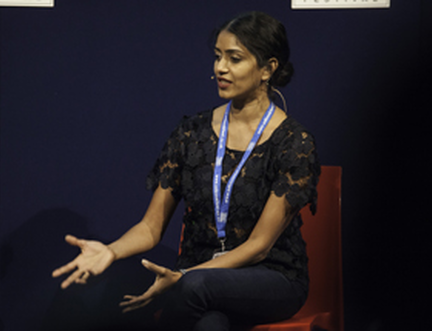More articles Saturday 27 August 2016 2:00pm
Healthcare in India: Heading for a Crisis?

When Aarathi Prasad decided to look into the state of medicine and healthcare in her mother’s homeland, India, she took on a subject of daunting cultural, social and economic complexity – and biting relevance. “I’ve always been interested in technology – not just science in a vacuum, but social applications of it,” said the biologist, writer and TV presenter at the Book Festival yesterday.
Her book The Bonesetter’s Waiting Room: Travels Through Indian Medicine chronicles her exploration of how Eastern and Western, traditional and technological forms co-exist in India, and how that country’s colonial history and vast economic disparity affects ordinary citizens’ interaction with medicine. Prior to the 1840s, Prasad pointed out, traditional Indian medicine was taught alongside Western forms. Thereafter, traditional medicine was banned – it could be studied as history, but not practiced. Which left a strange situation when independence came in 1947.
“When colonisers leave, do you keep the medicine they brought and leave the medicine they banned? Do you revert to the traditional forms? Or do you have a synthesis of the two?” Such questions, she said, remain unanswered, and yet a hierarchy exists – as well as a prohibitively expensive private healthcare system, and a lack of doctors. “Technically, it’s a pick and mix. But as with anywhere else, it increasingly depends on what you can afford. And Western medicine is aspirational.” Yet traditional forms, the efficacy of which is scientifically undetermined, retain a powerful hold.
In her book Prasad details a mass annual event whereby 70 – 80,000 people travel to the southern city of Hyderabad in order to consume an asthma cure which entails swallowing a live fish stuffed with herbs. Does it work? Hard to say, Prasad contends. “It’s plant-based; there are active ingredients in it.” Ayurvedic medicine has yet to be fully tested or properly understood by Western systems and standards. But an understanding of the chemical processes at work is only part of the story. The engagement of Indian traditional healers with their patients involves a blend of herbal remedies and psychology.
“One of the key things that differentiates Western medicine from any Asian system is that Asian systems see body and mind as linked. Folk healers know how you fit into your community they see you in your life – they clock where the problem is coming from.” As for the herbal compounds, Prasad quotes a researcher currently involved in setting up and testing a database of Ayurvedic remedies: “’I don’t really need evidence to know that it works. We’ve been using it for 5000 years: we know it works. We just don’t know why it works.”
A sophisticated blend of this instinctive, natural, community-oriented approach with Western technologies might seem like a medical dream ticket. But access to medical care in India is increasingly expensive, and the gap in income increasingly vast. “There is a place for private and public medicine, no doubt about that,” said Prasad. “But the government is providing opportunities for private hospitals and less that 1% of funding is going into public hospitals. It’s hard to exaggerate how bad they are.” She pronounced herself “stumped” by the apparent lack of government concern with healthcare. “You’re wasting the biggest resource a country has, which is its people. The government needs to engage with it – this can’t go on. It’s not enough anymore for certain sections of the community getting richer. It has to be distributed. I can’t imagine why people don’t go to Delhi en masse and demand social healthcare.”
- 2026 Festival:
- 15-30 August
Latest News
 Major new partnership with Celtic Connections
Major new partnership with Celtic Connections



